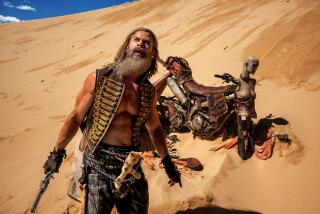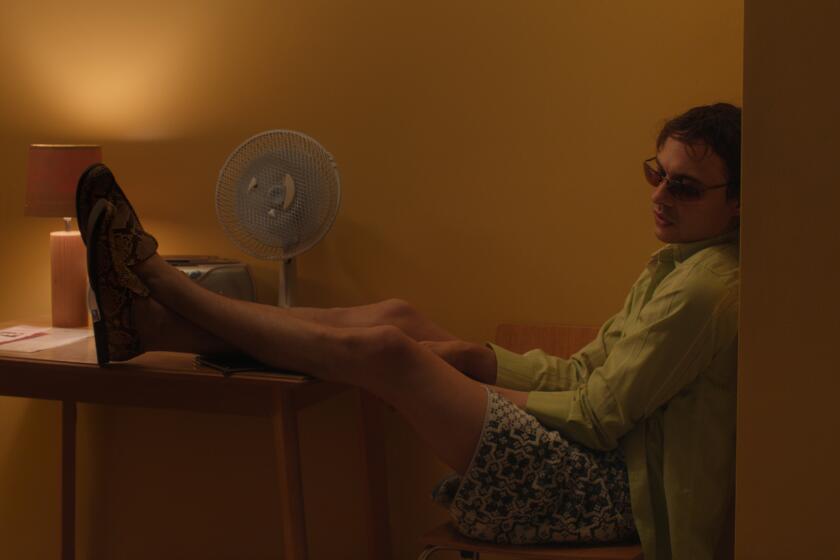Gore Verbinski opens up about his Hollywood hiatus, finding ‘A Cure for Wellness’ and sock puppets

- Share via
In an earlier life, years before he became a big-time filmmaker, Gore Verbinski played guitar in a string of Los Angeles punk bands, banging out in-your-face songs with titles like “Hate You,” “Choke on It” and “I Wanna Die Like Elvis Did.”
Alas, rock stardom wasn’t to be, and eventually Verbinski turned to directing music videos, which led to making blockbusters like the 2002 horror hit “The Ring,” three wildly successful “Pirates of the Caribbean” movies and 2011’s Oscar-winning animated movie “Rango.”
Still, he says, Hollywood never tamed his inner teenage punk.
“The spirit is the same,” Verbinski, 52, said on a recent afternoon in Los Angeles, his thoughtful, soft-spoken demeanor belying his snarling hard-rock roots. “It’s not just about anarchy or ‘tear it down.’ It’s more that kind of snickering joy you get in saying, ‘We don’t know if this is going to work. This is absolutely crazy. Let’s go deeper.’ ”
That gonzo, go-for-broke approach has been evident in even Verbinski’s most broadly commercial movies — just ask the Disney executives who famously panicked at the initial sight of Johnny Depp’s slurring, Keith Richards-esque performance as Capt. Jack Sparrow in the first “Pirates” film. And it’s on full display in nearly every frame of Verbinski’s new film, “A Cure for Wellness,” which opens Friday.
A bizarro Grand Guignol psychological thriller about a young business executive (Dane DeHaan) who is sent to a rehabilitation spa in the Swiss Alps from which no one ever leaves, “A Cure for Wellness” is a creepy, slow-burning exploration of the porous boundary between health and sickness, sanity and madness, packed with disturbing, visually striking images of slithering eels, torturous dentistry and eerily empty hallways. In an R-rated horror genre that has come to be dominated by gimmicky hooks and cheap jump scares, it’s a square peg in a round hole.

“It’s not immediately reducible, and that’s the challenge,” Verbinski said. “We’re trying to say, ‘Remember what it was like to go to a movie and you didn’t know anything about it — you hadn’t played the game or read the book?’ And that’s tricky. This film needs to find its champions.”
As it happens, the same thing could be said for Verbinski himself. For the director, “A Cure for Wellness” represents a chance to get back on track nearly four years after suffering one of the most bruising, high-profile flops in recent Hollywood history. As Verbinski put it, borrowing the terminology of modern tentpole moviemaking, “I think there’s a sense of a reboot.”
Following a string of massive blockbusters — including a trio of “Pirates” movies that collectively earned $2.7 billion worldwide — Verbinski’s run as one of the industry’s top hitmakers slammed into a wall with 2013’s “The Lone Ranger.”
The worst is going on the press tour.
— Director Gore Verbinski on “The Lone Ranger”
Budgeted at an estimated $225 million — an eyebrow-raising amount for a Western based on an antique franchise dating back to the golden age of radio — “The Lone Ranger” underwent a notoriously problem-plagued production and drew fire for the casting of Depp as Native American sidekick Tonto. Saddled with negative buzz, it was crushed at the box office its opening weekend by “Despicable Me 2.” The film eventually grossed $260 million worldwide, far below expectations, leading Disney to take a write-down of as much as $190 million for the production. By comparison, Verbinski’s “Pirates of the Caribbean: Dead Man’s Chest” grossed $1.1 billion worldwide in 2006.
In a business where you’re often only as good as your last hit, Verbinski knew “The Lone Ranger” was the kind of bomb that can lead to a protracted sentence in directors jail. Despite that difficult experience (“The worst is going on the press tour,” Verbinski said quietly), he refused to wallow in angst. He had other movies he wanted to make.
“You live by the sword, you know,” he said matter-of-factly. “It’s going to happen. And not to be cute, but you get back on the horse. It’s about the work. When you have a story you want to tell, you’re going to figure out how to make it — even if it has to be with sock puppets.”
Screenwriter Justin Haythe, who wrote both “The Lone Ranger” and “A Cure for Wellness,” says he admires the way Verbinski weathered that storm and came out the other side.
“There was a huge target on ‘The Lone Ranger’ partly because I think people viewed it as a cynical attempt to cash the ‘Pirates’ check again in the Old West,” Haythe said. “But Gore is not going to be cowed. He’s uncompromising in the most wonderful way. He doesn’t need 10 houses and private planes. He’s very happy to continue to take huge risks, which is rare.”
On the immediate heels of “The Lone Ranger,” Verbinski suffered another setback when his next planned project, a North Korea-set film called “Pyongyang” that was to star Steve Carell, was scrapped by nervous backers just eight weeks away from production in the wake of the 2014 Sony hack.
“It wasn’t my choice. I wasn’t worried about my emails,” Verbinski said. “It was people way above my pay grade who were worried about their emails.” (In a statement after the project was canceled, the director said, “I find it ironic that fear is eliminating the possibility to tell stories that depict our ability to overcome fear.”)
Though the subject of North Korea remains too hot for most Hollywood financiers to handle, Verbinski still holds out hope of making the film someday. “I don’t want to talk too much about it,” he said. “If it ever does happen, I want it to be done before anyone knows about it.”
With a production budget of $40 million, “A Cure for Wellness” — much of which was filmed in an abandoned former military hospital outside Berlin where Nazi soldiers were treated during World War II — cost a fraction of gargantuan productions like “The Lone Ranger” and the “Pirates” movies. For Verbinski, that lower overhead was creatively freeing.
Remember what it was like to go to a movie and you didn’t know anything about it — you hadn’t played the game or read the book?
— Gore Verbinski, director

The trailer for “A Cure For Wellness.”
“Everybody has to like those movies — four quadrants — and that’s the burden,” he said. “It’s liberating to be able to say, ‘This isn’t for everybody. Don’t bring your kids.’ ”
While tentpole studio filmmaking is considered the brass ring for many hungry young filmmakers, Verbinski says he has no burning desire to return to that high-stakes realm. “I would say, ‘Never say never,’ but not immediately,” he said. “If you can have a bag that’s one-third full but you have autonomy — that’s a much better place to be. I’ve got a few things I’m playing with: a couple of movie ideas, a couple of animated ideas. I might try some long-form. So I’ll push down on all the pedals and see.”
As for the “Pirates” franchise that first launched him into that realm 14 years ago, when it became clear that Disney wanted to continue with the seafaring series after the first three installments, Verbinski decided to jump ship. (A fifth “Pirates” movie is due in theaters in May.)
“I’m not learning anything anymore,” he explained. “I wish them well, and we’re still kind of in touch. But there’s no reason other than financial, and I think that that’s death. There are easier ways to make a living.”
Not that Verbinski is looking for easy. Just as it was back in his punk days, what he considers his comfort zone is another person’s idea of the edge of possible calamity. If that means he might occasionally give the executives in risk-averse Hollywood heart palpitations, so be it.
When you have a story you want to tell, you’re going to figure out how to make it — even if it has to be with sock puppets.
— Director Gore Verbinski
“The joy of tinkering and maybe something will blow up. Sitting on that seam and sort of dancing in that area — that’s what keeps your blood pumping,” he said. “Every movie is going to be your last, so it better not be, you know, ‘Jumanji 6.’ You’d better put everything you can into the thing.”
Twitter: @joshrottenberg
ALSO
The ‘big three’ Oscar directors talk about their movies and their awards season journeys
The jokes, the scene (oh, and the winners) at the film academy’s Scientific and Technical Awards
More to Read
Only good movies
Get the Indie Focus newsletter, Mark Olsen's weekly guide to the world of cinema.
You may occasionally receive promotional content from the Los Angeles Times.











